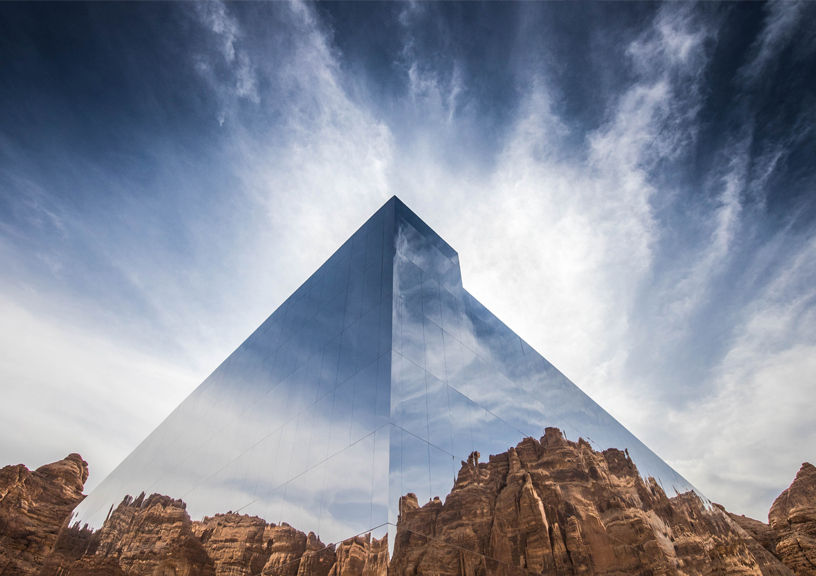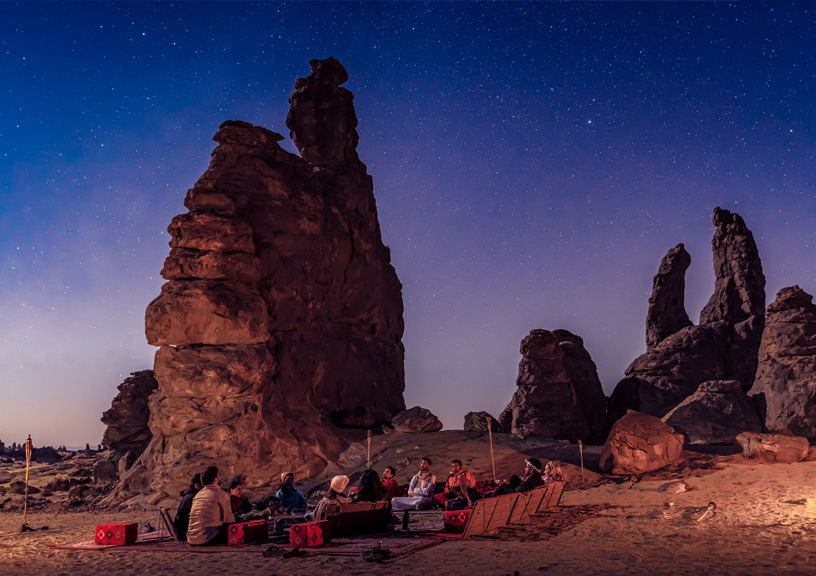Desert X was my first encounter with AlUla. The vision of large-scale spectacular art commissions set against the backdrop of AlUla’s breathtaking dunes, terracotta cliffs and heritage sites, was intriguing. One image left a lasting impact— that of artist Manal AlDowayan’s site-specific installation “Now you See Me, Now you Don’t”. Here, AlDowayan presented a set of puddle-like installations; they do not belong to this landscape, and yet they appear, paused, contained, existing in the crevices of the AlUla rocks. The puddles are not real, but are made of massive trampolines that can be touched, laid upon, jumped on, and observed. In the evening, they become moon circles, activated through a series of lighting techniques as people interact with them. The trampolines were meant to draw attention to water scarcity. The image lingered and the fascination for the land got etched in my memory.


It’s how history co-exists with the present, how the built landscape merges with the topography, how art and culture stay relevant, even as the city continues to evolve and embraces its new-found liberty that puts AlUla on the global map. Much has been written about the surreal topography and the layered history of the land. But AlUla is also slowly emerging as an arts and culture hub in Saudi Arabia that’s drawing in a new generation of intrepid travellers.
Once known as a ‘lost city of the dead’, AlUla is today a living museum that is home to ancient civilisations, historical sites and archaeological wonders dating back 200,000 years.

Located in Medina province in the northwest of Saudi Arabia and covering an area of more than 22,000 sq km, it is known for its sandstone mountains and fertile oases. Due to its location as an ancient crossroads on the Arabian Peninsula, it was an ideal resting place for caravan traders who would travel great distances in the region. The kingdom was closed to tourists until recently. AlUla is perhaps Saudi Arabia’s best-kept secret.

The landscape is surreal, layered. To start with, the desert and the majestic pre-Cambrian sandstone cliffs, which were under the sea some million years ago and formed by the compression of sediments, serve postcard-perfect visuals. This is interspersed with hand- carved monuments, mostly tombs that stand majestic and tall, and modern architectural interventions that camouflage into the landscape effortlessly. The Banyan Tree Tent Resort, which is a new property in the Ashar Valley, illustrates this seamless merger perfectly.

The architects at AW² took an environmentally-friendly, light-touch approach to the design, which aims to blend the resort seamlessly with the natural scenery of the Ashar valley. Various sand-colored canvases were used to create natural ventilation between the roof and the tent, as well as to provide sun protection. This three-tiered design creates soft roof lines blending the architecture into the existing landscape. The swimming pool sits in a natural crevice in the rocks, reminiscent of the Wadis that appear at the foot of the cliffs during rain spells.

From my villa at Banyan Tree, I could see a mirage; when you are in a desert, all you can think of is spotting an oasis. It was only later that day, on our drive to Hegra that we drove past Maraya—the world’s largest mirrored structure. Maraya is almost like an aberration or an apparition that teases your perception of sight. Designed by Gio Forma Studio, it comprises a giant mirror cube that makes us reflect on the incomparable spectacle of the geological epic, the radical abstraction of the surroundings and the singular incursions of man into the landscape. The mirrored façade glorifies and amplifies the surroundings instead of competing with nature. Unique in its genre, the landscape itself becomes an exhibition space.

The architecture, the choice of materials, everything is in stark contrast to its surroundings, yet it merges with it so seamlessly that you almost miss it until you walk past and experience this architectural marvel. The state-of-the-art structure is covered in 9,740 mirrored panels making it the largest mirrored building in the world, according to Guinness World Records. As the perfect modern ode to the past, Maraya is the centrepiece of AlUla’s growing cultural scene. From spectacular concerts and thrilling performances to art residency programmes and arthouse films, AlUla is emerging as a cultural centre on a global scale.

The place is a heady mixture, where monumental landscape keeps you company throughout your journey, where you oscillate between the past and the present. Our next stop was Hegra, a cemetery of a hundred tombs hewn into a red outcrop. The archaeological site of Al-Hijr is the first World Heritage property to be inscribed in Saudi Arabia. Formerly known as Hegra, it is the largest conserved site of the civilisation of the Nabataeans, south of Petra in Jordan. We also visited Jabal Ikmah, known as Saudi Arabia’s open library. A visit to this magnificent site, with its inscriptions thought to date as far back as the 1st millennium BCE, is a glimpse into the past. The Rawi (storytellers or guides) tells us that these inscriptions provide us an insight into the daily lives of the people in the Dadanite, Lihyanite and other civilisations of AlUla.

One of AlUla’s biggest charms is the incredible effort that has gone into preserving its heritage. Nowhere is this more obvious than in the Old Town, a labyrinth of nearly a thousand mud-brick houses. A section of the old town has been restored into chic boutiques and cafes! A stroll in the outdoor market is much recommended. We also made a brief stop at Madrasat Addeerah. In 1964, this building was Saudi’s first girls’ school. Today, Madrasat Addeerah is an arts and traditional crafts hub. Taken over by the Royal Commission for Alula in 2019, the school is now a thriving art space, with over 70 students perfecting their skills in spaces including ceramic, jewellery, pottery, wicker making and more. Our guide for the day makes a very interesting point, “Here, history and culture is not isolated. It’s omnipresent. The past co-exists with the present. The locals wake up to their legacy every morning. The landscape is their legacy.”

Okto at the Harrat Viewing Point is yet another unforgettable experience. Nothing prepares you for the all-black Greek fine-dining space. From here, you get a stunning view of the land of contrasts. The food is outstanding anywhere you eat in AlUla, but the food here is something else. We also stayed at the Habitas Resort, which is inimitable in its experience. “Habitas wants to redefine the idea of luxury—for a long time it implied material luxury and isolation,” says Habitas co-founder and CEO Oliver Ripley. “We believe that luxury is something that cannot be bought or sold; rather it is a feeling that exists in the experiences and memories we create with others. We call this luxury for the soul.”

Key to fostering that feeling are the property’s 100 stand-alone capsules made from laminated wood, aluminum, and other light-on-the-planet materials that Habitas constructs, flat packs, and then ships to the site for construction. (Yes, it’s rather like Ikea.) “We use CAD and digital 3D models of our rooms and structures, which we then translate into the machines that automate fabrication of the room structures and panels,” Ripley says. “Our development process is end to end. We design, manufacture, develop, and operate and so we are able to control the entire value chain from the materials we use.”

Perhaps the best way to experience AlUla is through a helicopter ride. This unique experience offers unrivalled views of ruins, monuments, Neolithic tombs. As the cultural and historical masterpiece unravels below you, your pilot will identify the stories of the dramatic landscape. You’ll see Maraya, the largest mirrored building in the world. From its surreal landscape carved both by man and nature, to modern day architectural interventions, AlUla never ceases to surprise you.
Image courtesy: The Royal Commission for Al-‘Ula
